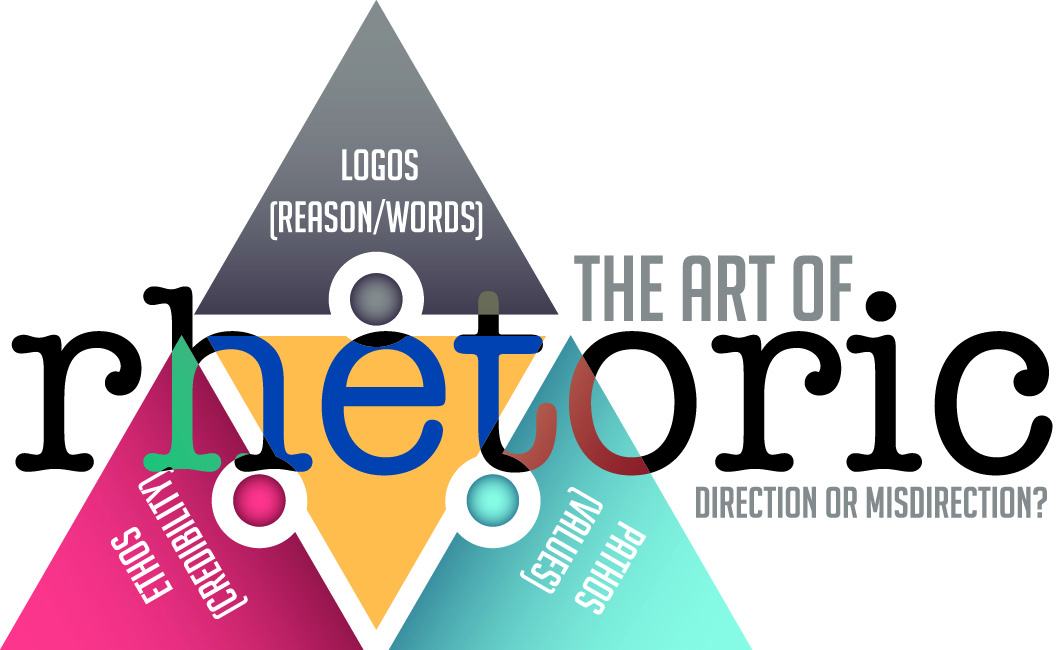- the art of effective or persuasive speaking or writing, especially the use of figures of speech and other compositional techniques.
- language designed to have a persuasive or impressive effect on its audience, but often regarded as lacking in sincerity or meaningful content.
Written by Jenifer Chrisman on December 29, 2014.
rhet•o•ric
/'redərik/
noun
Used to modify perspective through the persuasive qualities of language, rhetorical speech and writing have long been a well documented form of communication. It uses various devices* to influence attitude or belief through implications, associations or connotations. It also can make an argument more psychologically persuasive, while neither adding to nor detracting from its logical worth.
In and of themselves, rhetorical devices are neither good nor bad. However, used in conjunction with rhetorical fallacies,* they can slant or distort perception, whether individually or in a small or large group dynamic, through use of distraction. Plato, who was not a fan of rhetoric, described it as “a form of flattery.”
Fallacies are irrelevant points or illegitimate arguments that undermine logic. Their common errors in reasoning lack evidence to support their claims. The below email (also seen on Facebook) went virile in 2012:
Distribution has begun..... refuse new coins!!!!!!!! True Americans will refuse these it has begun. (George Washington The president Gold like coin with the time of which he is born-until death.) Refuse New Coins. This simple action will make a strong statement. Please help do this...refuse to accept these when they are handed to you. I received one from the Post Office as a change and I asked for a dollar bill instead. The Lady just smiled and said, “Way to go,” So, she had read this e-mail. Please help out...our world is in enough trouble without this too!!!!!! U.S. Government to release New Dollar Coins You Guessed it ‘IN GOD WE TRUST’ IS TOTALLY GONE. from the FRONT AND BACK. IF EVER THERE WAS A REASON TO BOYCOTT SOMETHING THIS IS IT!!!!!!! DO NOT ACCEPT THE NEW DOLLAR COINS AS CHANGE TOGETHER WE CAN FORCE THEM OUT OF CIRCULATION.
Several fallacies* were used in this email/ post including, but not limited to: sentimental appeal (True Americans), hasty generalization (So, she had read this e-mail) and equivocation (IN GOD WE TRUST’ IS TOTALLY GONE from the FRONT AND BACK).
While it is true the U.S. Mint created the $1 presidential coin program (starting in 2007), and it also was true “In God We Trust” was never intended to be on the obverse or reverse sides, at least on the first 15 coins, the coins did have “In God We Trust.” Along with E Pluribus Unum, “In God We Trust” was placed on the edging through the use of a new minting process.
With decent Internet and a quick trip to usmint.gov, taking less than a minute on average, anyone checking the validity of this story would have seen the negative rhetoric behind this email. An additional search using “in god we trust coin” would have brought up several sites that noted “In God We Trust” did not appear on the first coin until the 1864 two-cent coin during Lincoln’s term as president.
Whether the U.S. Mint intended to remove “In God We Trust” from the edge and place it on the obverse (front side) of the coin during the production of Lincoln’s coin and the rest from that point further, the public outcry stemming from that email/ post was so strenuous “In God We Trust” was removed from the edge and placed on the bottom left of the obverse side. This began with the first coin of 2009, William Henry Harrison, ninth president from March to April 1941. All coins since then have “In God We Trust” on the obverse.
Not surprisingly, as this was a new process in minting and an unspecified number of early coins were inadvertently released without the inscription on the edging, this was never noted in the email/post. The U.S. Mint released a statement in March of 2007, but as this information would have been detrimental to the rhetorical fallacies of the email/post it was left out.
Rhetoric, which is especially common in campaign advertising, used properly can greatly enhance writing or speech. Used to slant or distort…it can do great damage and lead others on a path they would not otherwise have chosen for themselves. Many campaign advertisements say their opponent did this or said that. While the opponent may have done/said exactly what the advertisement claims, unless all context is referenced, what was done/said may hold no negative or derogatory meaning.
Where rhetoric is involved a grain of salt should always be on hand. In extreme cases the whole cellar might be needed. In the words of Ray Comfort, “Rhetoric, which is the use of language to inform or persuade, is very important in shaping public opinion. We are very easily fooled by language and how it is used by others.”
*Notes: See Rhetorical Devices & Fallacies for more details.



